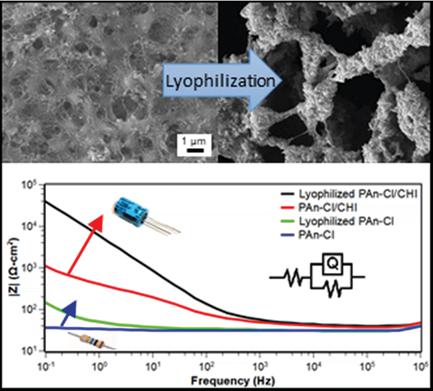当前位置:
X-MOL 学术
›
Adv. Electron. Mater.
›
论文详情
Our official English website, www.x-mol.net, welcomes your
feedback! (Note: you will need to create a separate account there.)
Chemiresistive and Chemicapacitive Devices Formed via Morphology Control of Electroconductive Bio‐nanocomposites
Advanced Electronic Materials ( IF 5.3 ) Pub Date : 2017-12-28 , DOI: 10.1002/aelm.201700495 John R. Aggas 1, 2 , Jodie Lutkenhaus 3 , Anthony Guiseppi-Elie 1, 2, 4
Advanced Electronic Materials ( IF 5.3 ) Pub Date : 2017-12-28 , DOI: 10.1002/aelm.201700495 John R. Aggas 1, 2 , Jodie Lutkenhaus 3 , Anthony Guiseppi-Elie 1, 2, 4
Affiliation

|
Chemiresistive and chemicapacitive circuit elements are fashioned from polymer thin films that are bio‐nanocomposites of polyaniline‐chloride (PAn‐Cl) nanofibers within a chitosan (CHI) matrix deposited on microfabricated electrodes (IAME‐co‐IME; 2 µm lines and 1 µm spacing). UV–vis spectroscopy of 0–100 wt% PAn‐Cl/CHI confirms no electronic coupling between PAn and CHI. When aqueous dispersions of the bio‐nanocomposite are slow dried or cast, frozen, and lyophilized, they produce dense (chemiresistive) or highly porous foam (chemicapacitive) membranes. Studied in air, deionized water, and in physiological buffers (PBS and HEPES), four‐band probe measurements of the ionic to polaronic conduction show a conductivity that is composition dependent with a percolation threshold of ≈30 wt%. Cyclic voltammetry reveals all compositions to be electroactive. Electrical impedance spectroscopy (EIS) shows that resistive and capacitive properties can be controlled by composition and morphology with 50–50 wt% being favored. EIS modeling confirms a modified Randles circuit of low chi‐square values (<0.05) that appropriately models the chemiresistive and chemicapacitive properties. DC offset voltages can externally control the predominantly chemiresistive and chemicapacitive properties of the devices for biosensor and biocircuit applications.
中文翻译:

通过导电生物纳米复合材料的形态控制形成的化学和化学容性设备
化学电阻和chemicapacitive电路元件由聚合物薄膜是的聚苯胺-氯(PAN-Cl)的脱乙酰壳多糖中的纳米纤维(CHI)基质沉积在微加工电极的生物纳米复合材料塑成(IAME-共-我; 2 µm线和1 µm间距)。紫外可见光谱为0–100 wt%PAn-Cl / CHI证实了PAn和CHI之间没有电子耦合。当将生物纳米复合材料的水分散体缓慢干燥或浇铸,冷冻和冻干时,它们会产生致密的(化学阻滞性)或高度多孔的泡沫(化学阻滞性)膜。在空气,去离子水和生理缓冲液(PBS和HEPES)中进行了研究,对离子至极化子传导的四波段探针测量显示,其电导率取决于渗透阈值≈30wt%。循环伏安法表明所有组合物都是电活性的。电阻抗光谱法(EIS)表明,电阻和电容特性可以通过组成和形态来控制,其中50-50 wt%是有利的。EIS建模证实了经过修改的低卡方值(<0.05)的Randles电路,可以适当地模拟化学阻性和化学容性特性。DC偏移电压可以从外部控制生物传感器和生物电路应用设备的主要化学抗性和化学电容性。
更新日期:2017-12-28
中文翻译:

通过导电生物纳米复合材料的形态控制形成的化学和化学容性设备
化学电阻和chemicapacitive电路元件由聚合物薄膜是的聚苯胺-氯(PAN-Cl)的脱乙酰壳多糖中的纳米纤维(CHI)基质沉积在微加工电极的生物纳米复合材料塑成(IAME-共-我; 2 µm线和1 µm间距)。紫外可见光谱为0–100 wt%PAn-Cl / CHI证实了PAn和CHI之间没有电子耦合。当将生物纳米复合材料的水分散体缓慢干燥或浇铸,冷冻和冻干时,它们会产生致密的(化学阻滞性)或高度多孔的泡沫(化学阻滞性)膜。在空气,去离子水和生理缓冲液(PBS和HEPES)中进行了研究,对离子至极化子传导的四波段探针测量显示,其电导率取决于渗透阈值≈30wt%。循环伏安法表明所有组合物都是电活性的。电阻抗光谱法(EIS)表明,电阻和电容特性可以通过组成和形态来控制,其中50-50 wt%是有利的。EIS建模证实了经过修改的低卡方值(<0.05)的Randles电路,可以适当地模拟化学阻性和化学容性特性。DC偏移电压可以从外部控制生物传感器和生物电路应用设备的主要化学抗性和化学电容性。











































 京公网安备 11010802027423号
京公网安备 11010802027423号